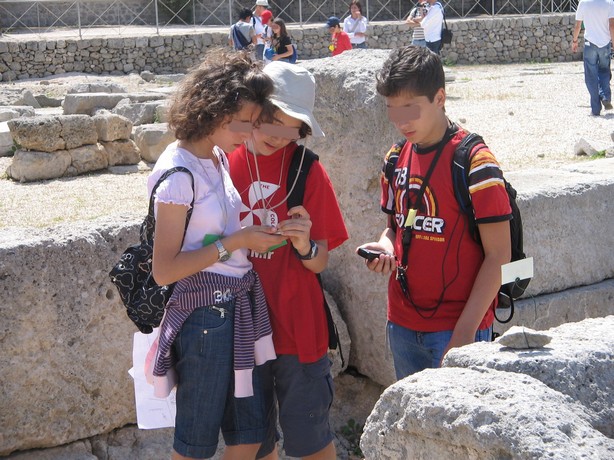
The Explore! m-learning system implements an excursion-game technique to help middle school students (ages 11 through 13) acquire historic knowledge while playing in an archaeological park. The excursion-game is perfectly suited to the archaeological park context, with its wide spaces where students, divided in groups, can move about freely and use their intelligence and imagination to conjure up how life used to be there, by observing the park and memorizing places, names and functions.
In Gaiusí Day, the game implemented for visiting the ruins of the ancient Egnathia, in Southern Italy, each student group impersonates Gaius, a Roman citizen who has recently arrived in Egnathia and sets out to explore the city. The group receives two cell phones, a paper map of the park, and a backpack carrying a pair of loudspeakers. In order to involve each student equally, the recommended group size is three students: one carries the first cell phone and the backpack, another is responsible for the second cell phone, and the third holds the map. |
Students playing Gaius' Day in Egnathia |
Striving for a simple, cheap digital gaming infrastructure, the design of Explore! is based on cell phones, complemented with compatible memory cards containing the game software. Visitors can use their own cell phones so the archaeological park does not need to provide any hardware infrastructure. To reduce costs and architectural complexity, no data are transmitted from or to the cell phone during the actual game; instead, all data exchange takes place between the cell phone and the memory card inside. A notebook and a projector are used for the debriefing phase: the notebook is equipped with a memory card reader for getting the game logfiles, which are stored in the cell phones as the group visits different parts of the park and answers questions. In the debriefing phase students and a game master play a collective memory game, where monuments and archaeological objects must be placed in the right location on the park map shown on the projected screen. The activities of any group can also be replayed, showing on the screen the path the group took across the archaeological park.
Explore! has been designed as device-independent and modular as possible, with a clear distinction between game content (historical information, 3D reconstructions, sounds, etc.) and game logic. The system is composed of three main modules. The first one, Game Application, exploits an XML file describing the game content (easily authored for each archaeological park) and an XML file stating the layout and relationships among the various audiovisual elements of the user interface. The second module, Hint Application, provides the cues for the game, also represented in XML. The third module, Debriefing Application, running on a notebook, gets the XML logfiles created during the game execution. The design based on XML files makes the Explore! system independent from mobile platforms. Due to outer circumstances, our current implementation is based on a combination of Microsoft .NET (for both Game Application and Debriefing Application) and J2ME (for Hint Application).
The current version of Explore! also implements sound, thanks to the Contextual Sounds Application, a software module of Explore! that defines the user’s position and produces a virtual sound environment. This module can easily be included in any system that needs to generate a contextual sound environment in outdoor settings. It behaves like the JSR234 DistanceAttenuationControl interface available on the J2ME platform, which controls how the sound originating from a source fades out as the distance from the user grows.